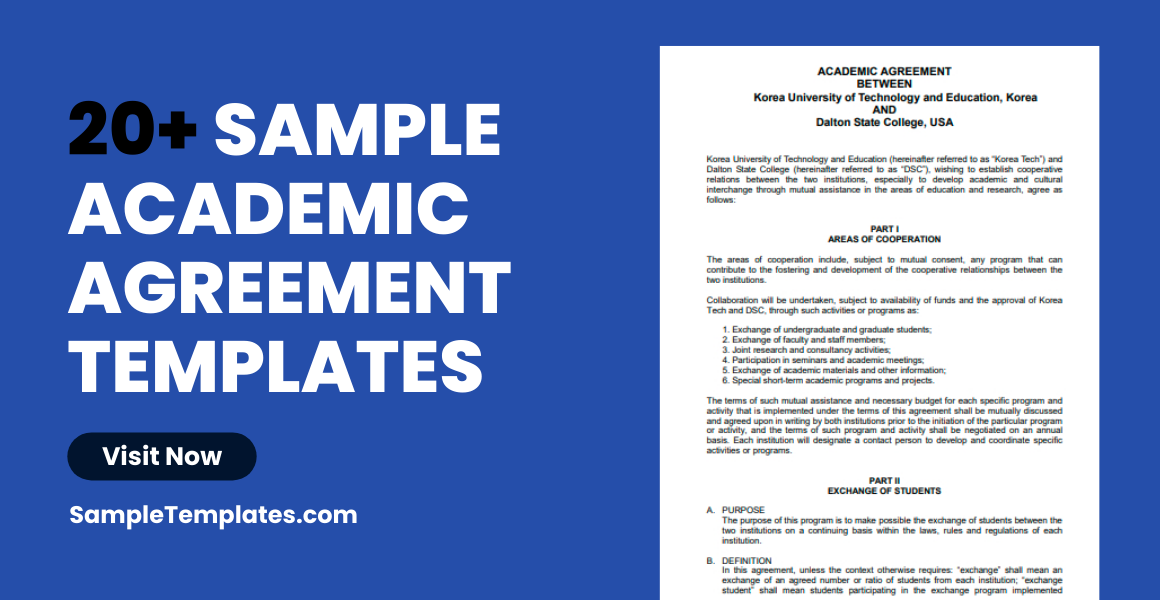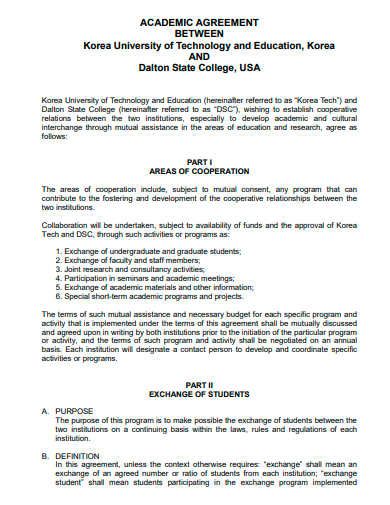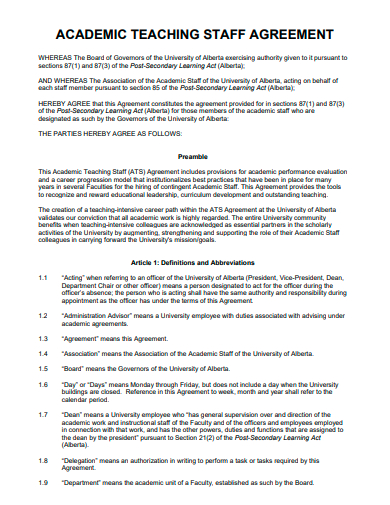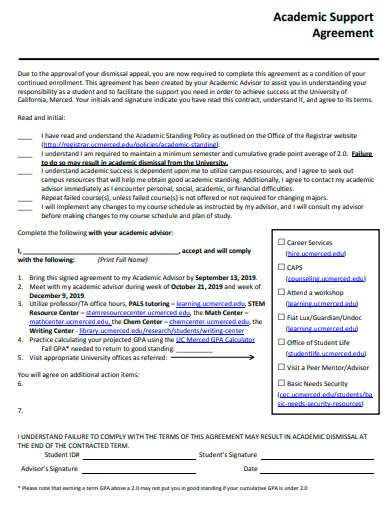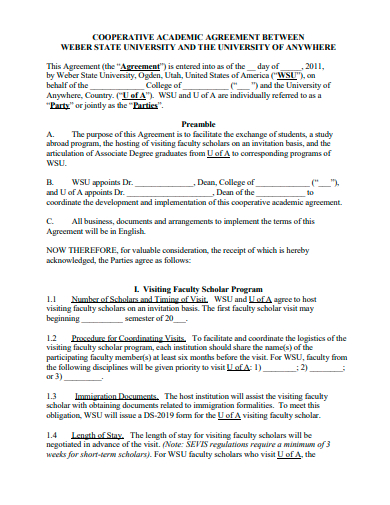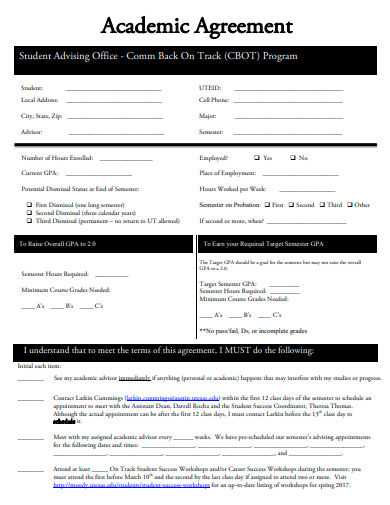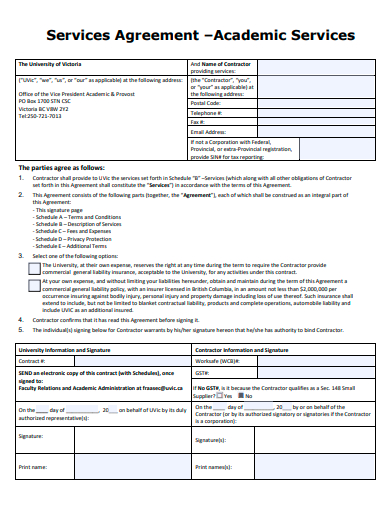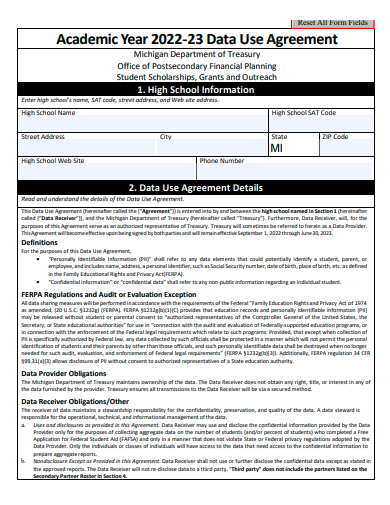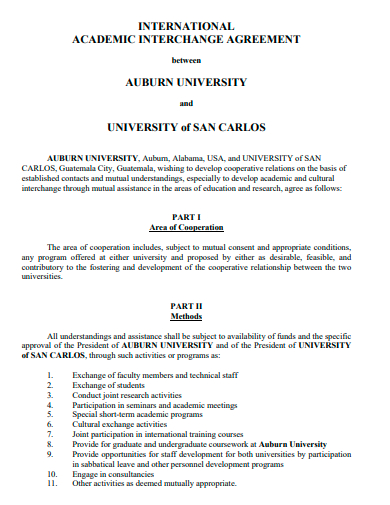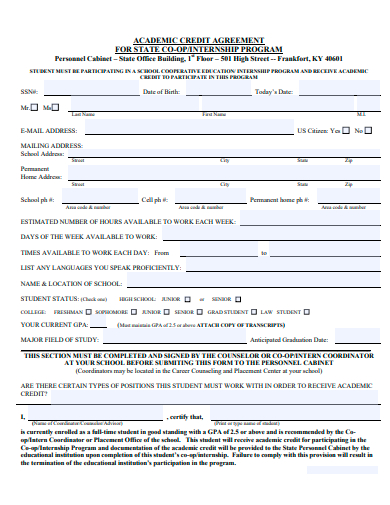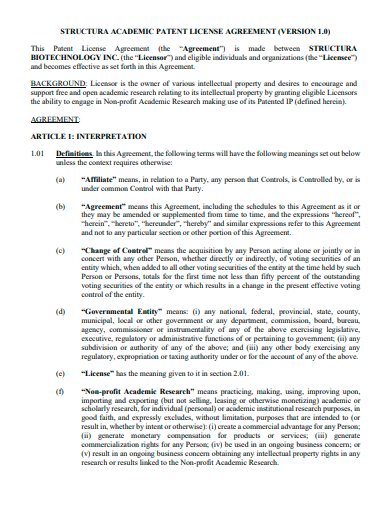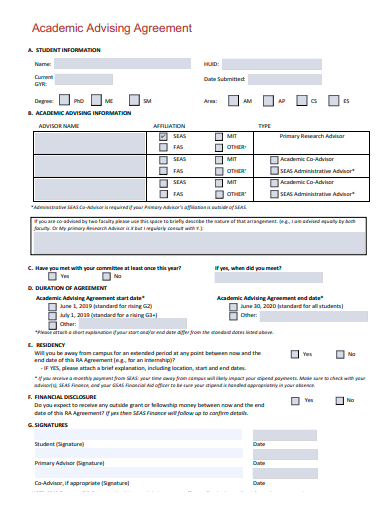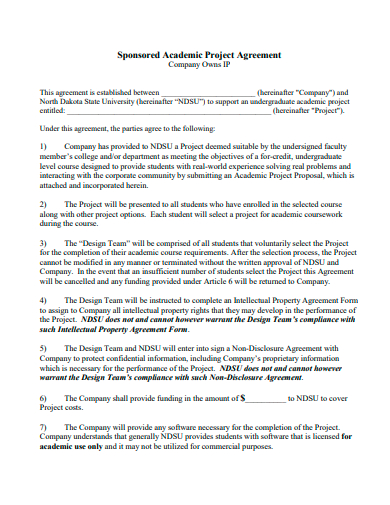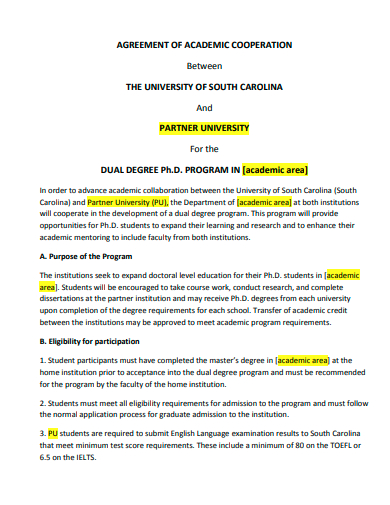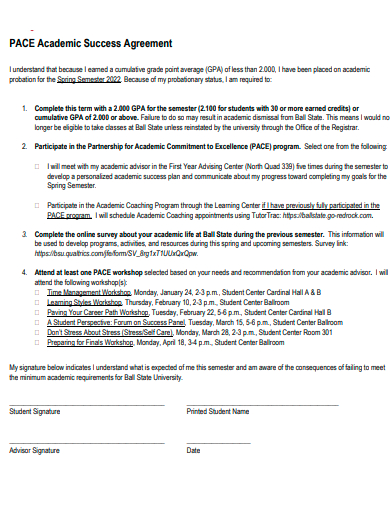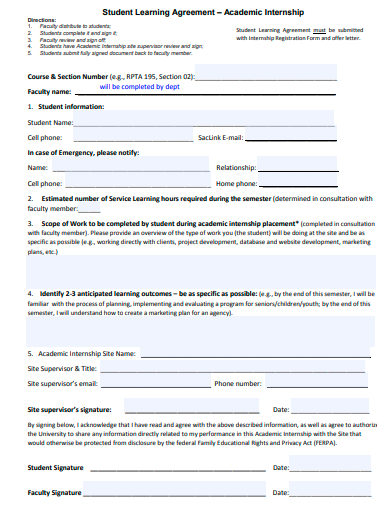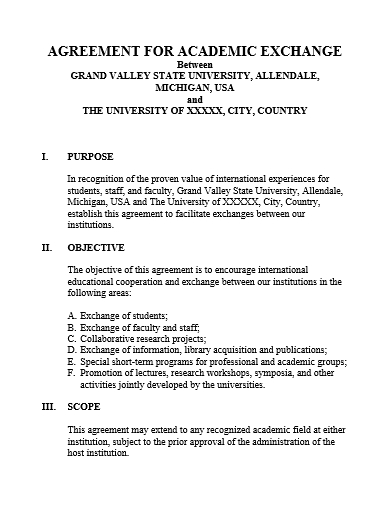Forging ahead in the intricate maze of academic collaborations, especially when student agreements are at play, requires an astute compass. Our Sample Academic Agreement Template emerges as that guiding tool for educators, students, and institutions. Tailored to address the nuances of student agreements, this flexible template merges excellence with comprehensibility. Immerse yourself in a framework designed to reflect best practices and shared aspirations.
20+ Academic Agreement Samples
1. Academic Agreement Template
2. Sample Academic Agreement Policy Template
3. Academic Teaching Staff Agreement Template
4. Sample Academic Agreement Request Form Template
What is an academic agreement?
An academic agreement is a formalized document that establishes the terms, conditions, and expectations for collaborations between academic entities, such as schools, universities, academic departments, research institutions, and sometimes even individual students. The primary purpose of such an simple agreement is to ensure that all parties involved have a clear understanding of their roles, responsibilities, and the expected outcomes of the collaboration.
Types of Academic Agreements
Articulation Agreements: Often used to facilitate the transition of students from one academic institution to another, particularly from a two-year to a four-year college. They ensure that credits earned at the originating institution are recognized and applied appropriately at the receiving institution.
Research Collaboration Agreements: Established between academic institutions or between an institution and a private organization to set the terms for collaborative research. Such agreements address issues like intellectual property rights, funding distribution, publication rights, and confidentiality.
Student Exchange Agreements: Facilitate the exchange of students between academic institutions, often internationally. These agreements detail the duration of the exchange, credit transfers, financial responsibilities, and other logistical aspects.
Teaching and Faculty Exchange Agreements: These agreements allow faculty members to teach or conduct research at another institution for a specified period. Terms might include compensation, accommodation, research facilities provided, and the duration of the exchange.
Importance of Academic Agreements
Clarity and Transparency: Academic agreements provide a clear roadmap of what is expected from each party. This transparency helps in preventing misunderstandings and potential conflicts down the line.
Protection of Rights: Especially in research collaborations, academic agreements protect the intellectual property rights of involved parties, ensuring that research outcomes, patents, or publications are fairly attributed.
Facilitation of Academic Progress: For students, agreements like articulation or exchange agreements can be crucial in ensuring their academic journey is smooth, with credits transferring appropriately and without unexpected roadblocks.
Fostering International Relations: Many academic agreements, especially those of student or faculty exchange, serve to strengthen ties between institutions across borders, promoting cultural exchange and global understanding.
Considerations When Drafting an Academic Agreement
Duration: Clearly state the start and end date of the agreement or specify the conditions under which the agreement can be renewed or terminated.
Roles and Responsibilities: A comprehensive breakdown of what is expected from each party prevents ambiguity.
Conflict Resolution: Address potential disputes by establishing a mechanism for resolution, be it through arbitration, mediation, or other means.
Confidentiality: In research or projects involving sensitive data, the agreement should detail how such information will be handled and protected.
Financial Aspects: Clearly outline any financial responsibilities, including funding for research, tuition for exchanged students, or compensation for faculty.
academic agreements, while often seen as bureaucratic necessities, play an essential role in facilitating effective collaboration in the world of academia. They ensure that all parties have a shared understanding and work cohesively towards mutual academic goals. As global collaboration increases in the academic realm, such agreements become even more vital in ensuring seamless cooperation and understanding across different academic cultures and systems.
5. Academic Support Agreement Template
6. Sample Cooperative Academic Agreement Template
7. Sample Academic Agreement Template
8. Academic Services Agreement Template
9. Academic Alliance Program Agreement Template
What Makes an Academic Agreement Important and Necessary?
The academic landscape is a complex web of interactions, partnerships, and collaborations, encompassing a range of activities from student exchanges to groundbreaking research. In this intricate setting, the academic agreement emerges not merely as a formality but as an indispensable tool. Let’s explore the significance and necessity of these agreements.
Ensures Clear Communication:
At the heart of any successful partnership is clear and effective communication. Academic agreements act as a written testament of mutual understandings and expectations. They articulate the specifics of collaboration, ensuring all parties are on the same page. This clarity minimizes the chances of misunderstandings or misinterpretations which could jeopardize the partnership.
Protects Rights and Interests:
Whether it’s safeguarding intellectual property in a joint research endeavor or preserving the rights of a student in an exchange program, academic agreements serve to protect the vested interests of all parties involved. They delineate the boundaries of ownership, credit, and responsibilities, offering a legal shield against potential infringements.
Provides Structure and Direction:
Academic collaborations can span months or even years. An agreement offers a structured framework, outlining the objectives, timelines, and milestones. This roadmap serves as a guiding light, providing direction to the collaboration and ensuring that the partnership remains focused and goal-oriented.
Facilitates Mutual Respect:
By formalizing roles, responsibilities, and expectations, academic agreements promote a culture of respect. They recognize the contributions and significance of each party, ensuring that all collaborators feel valued and acknowledged.
Ensures Accountability:
The binding nature of an academic agreement means that there are consequences for non-compliance. This sense of accountability ensures that all parties involved adhere to their commitments, whether it’s delivering research on time or abiding by the terms of a student exchange program.
Streamlines Administrative Processes:
For institutions, administrative efficiency is paramount. Academic agreements simplify and streamline various administrative processes. For instance, an articulation agreement between institutions can expedite the credit transfer process for students, making transitions smoother.
Cultivates Trust:
Trust is the bedrock of any successful collaboration. By committing to a written agreement, parties demonstrate their commitment and reliability to one another. Over time, this fosters an environment of trust, making future collaborations more likely and more fruitful.
Addresses Potential Risks:
Every collaboration comes with its set of risks, be it financial, reputational, or operational. Academic agreements, with their detailed clauses and provisions, preemptively address and mitigate these risks. This proactive approach ensures that partnerships can navigate challenges effectively.
An academic agreement is more than just a document; it’s the embodiment of the collaborative spirit, a testament to mutual goals and shared visions. In the ever-evolving realm of academia, where the boundaries of knowledge and collaboration are continually expanding, such agreements are not just important—they are imperative. They provide the stability and assurance needed for academic entities and individuals to come together, innovate, and push the boundaries of what’s possible.
10. Sample Academic Data Use Agreement Template
11. Academic Interchange Agreement Template
12. Academic License Agreement Template
13. Sample Academic Plan Agreement Template
14. Academic Credit Agreement Template
How Effective Is Your Student Academic Agreement?
In the intricate tapestry of academic life, one of the pivotal threads that holds the entire framework together is the student academic agreement. It acts as a binding contract, defining the terms of engagement between a student and an educational institution. But like any contract, its effectiveness is contingent upon various factors. How, then, can one gauge the effectiveness of a student academic agreement? Let’s delve into the criteria that determine its efficacy.
Clarity of Terms:
One of the hallmarks of an effective student academic agreement is its clarity. Every clause, every term, and every condition should be clearly spelled out. Ambiguous language can lead to misunderstandings, conflicts, and potential legal issues. Whether it’s about tuition fees, academic expectations, code of conduct, or campus facilities, each stipulation should be unambiguous.
Relevance to Current Academic Environment:
An effective agreement stays current and relevant. With the rapid evolution of the academic environment due to technological advancements and changing global dynamics, it’s imperative that the agreement remains in sync with contemporary needs. Periodic reviews and updates ensure it remains pertinent.
Accessibility and Understanding:
An effective academic agreement is not just a document that gets archived; it should be easily accessible to students. Furthermore, institutions have a responsibility to ensure students comprehend its terms. Holding orientation sessions or Q&A forums can be a proactive approach to facilitate this understanding.
Provisions for Dispute Resolution:
Conflicts are an inevitable part of human interaction. An effective agreement outlines clear mechanisms for conflict resolution, whether through mediation, counseling, or more formal channels. This not only provides a roadmap for addressing issues but also instills confidence in students about the fairness of the system.
Flexibility and Adaptability:
While it’s essential for the agreement to be firm on its terms, it should also have the flexibility to accommodate exceptional cases. Life is unpredictable, and students might face unforeseen challenges. The agreement’s ability to adapt to genuine circumstances, within reasonable bounds, is a testament to its effectiveness.
Regular Feedback Mechanisms:
The best way to know if an agreement is serving its purpose is by seeking feedback. Institutions should regularly solicit feedback from students regarding the agreement. This feedback loop can offer insights into areas of improvement and potential gaps.
Compliance and Enforcement:
An agreement, no matter how well-drafted, is only as effective as its enforcement. Institutions must have mechanisms in place to ensure compliance with the agreement’s terms. This includes both honoring commitments made to students and holding students accountable for their responsibilities.
A student academic agreement is more than a piece of paper; it’s a commitment, a promise, and a guide. Its effectiveness is a measure of the mutual respect between an institution and its students. While drafting and updating the agreement requires effort and diligence, the dividends it pays in fostering a harmonious, transparent, and conducive academic environment are immeasurable. Institutions that prioritize the effectiveness of their student academic agreements are investing in the foundation of a successful academic journey for every student.
15. Sample Academic Patent License Agreement Template
16. Academic Advising Agreement Template
17. Sponsored Academic Project Agreement Template
18. Sample Academic Cooperation Agreement Template
19. Academic Success Agreement Template
20. Academic Internship Student Learning Agreement Template
21. Academic Exchange Agreement in DOC
Tips in Creating an Academic Agreement
Crafting an academic agreement is an intricate endeavor that establishes the foundation for partnerships, collaborations, and mutual understandings within the academic realm. Whether it’s between institutions, departments, researchers, or even students, a well-constructed agreement is vital. Here are several tips to guide the process of creating an effective academic agreement:
Establish Clear Objectives:
Begin by outlining the primary goals and objectives of the agreement. What do both parties hope to achieve? Whether it’s for research collaboration, student exchange, or faculty partnerships, having a clear purpose will guide the subsequent terms and clauses.
Use Clear and Concise Language:
Avoid using dense legalese or jargon. Instead, opt for clear, straightforward language that can be easily understood by all parties involved. This ensures transparency and minimizes potential misunderstandings.
Define Roles and Responsibilities:
Clearly demarcate the roles, duties, and responsibilities of each party. This not only avoids confusion but also ensures that every entity knows what is expected of them, reducing the chance of conflicts in the future.
Address Financial Aspects:
If there are financial implications – be it in terms of funding a research project, handling tuition fees, or managing shared resources – these should be detailed explicitly. This includes the amount, payment schedules, and responsibilities regarding financial mishaps or unexpected expenses.
Include Confidentiality and Intellectual Property Clauses:
For research collaborations or partnerships involving shared resources, it’s essential to address how intellectual property will be handled. Who owns the results? How will credits be shared in publications? Similarly, if there are any confidentiality requirements, they should be explicitly laid out.
Set Out Dispute Resolution Mechanisms:
Even with the best intentions, disagreements can arise. An effective academic agreement will provide mechanisms for resolving disputes, whether through mediation, arbitration, or other means.
Provide for Periodic Reviews:
The academic world is dynamic, with changing needs and advancements. Make provisions for periodic reviews of the agreement to ensure its continued relevance. This allows both parties to make amendments and adjustments as required.
Ensure Compliance with Laws and Regulations:
Ensure that the agreement is in compliance with local, state, and federal laws, as well as any relevant institutional policies or international standards, especially if the collaboration is cross-border.
Consult Stakeholders:
Before finalizing, consult with the key stakeholders involved. This can include department heads, legal teams, researchers, or even students, depending on the nature of the agreement. Their feedback can be invaluable in refining the document.
Make Exit and Termination Clauses Clear:
While it’s optimistic to think of the fruitful outcomes of a collaboration, it’s also prudent to prepare for unforeseen circumstances. Clearly state the terms under which the agreement can be terminated by either party and the procedures for an amicable exit.
An academic agreement, when crafted thoughtfully, can be the cornerstone of fruitful collaborations and partnerships in the academic sphere. It offers a clear roadmap, fosters mutual respect, and ensures that all parties are aligned in their objectives and expectations. By following these tips, institutions and individuals can lay a robust foundation for academic success and cooperation.
Related Posts
FREE 10+ Mentoring Agreement Samples In MS Word | Apple Pages | PDF
FREE 10+ Partner Agreement Samples In MS Word | Google Docs | Apple Pages | PDF
FREE 10+ Individual Agreement Samples In MS Word | Google Docs | Apple Pages | PDF
FREE 10+ Strategic Agreement Samples In MS Word | Google Docs | Apple Pages | PDF
FREE 10+ Equity Agreement Samples In MS Word | Google Docs | Apple Pages | PDF
FREE 10+ Producer Agreement Samples in MS Word | Apple Pages | PDF
FREE 10+ Grant Agreement Samples In MS Word | Apple Pages | PDF
FREE 8+ Meeting Agreement Samples in MS Word | Google Docs | Apple Pages | PDF
FREE 10+ Community Agreement Samples In MS Word | Google Docs | PDF
FREE 8+ Real Estate Option Agreement Samples in MS Word | PDF
FREE 10+ Call Option Agreement Samples In MS Word | PDF
FREE 10+ Advertising Agreement Samples In MS Word | Google Docs | Apple Pages | PDF
FREE 10+ Car Agreement Samples In MS Word | Google Docs | Apple Pages | PDF
FREE 10+ Horse Agreement Samples In MS Word | Apple Pages | PDF
FREE 10+ Option Agreement Samples In MS Word | Google Docs | Apple Pages | PDF
